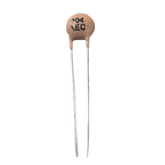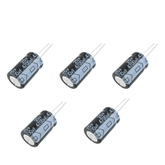What is Capacitor and how does it work?
Summary
Are you curious about capacitors? Look no further! Our latest blog post dives deep into capacitors, unravelling their mysteries and shedding light on their fascinating workings. Learn about capacitor construction, discover how they function, and delve into the secrets of capacitor dielectric working principles. We'll also explore the various types of capacitors available, their unique characteristics, and their applications in diverse industries. Whether you're a tech enthusiast or a novice, this engaging and informative read will leave you captivated and craving more knowledge about this essential electronic component.
What is Capacitor?
The capacitor is a linear two-terminal device that is used to store electrical charge. This contains two conducting plates in close vicinity separated with dielectric material between them.
There are three types of capacitors in use:
- Polar Capacitors.
- Non-Polar capacitors.
- Variable capacitors.
Capacitors come in various materials such as electrolytic, ceramic, etc., and come in different packages such as SMD, Through hole type.

Capacitor construction
All capacitors have a similar construction. It consists of two electrically conducting metal plates in close vicinity to each other, the metal plates are not touching each other instead they are separated using an insulating material.
The insulating material is termed dielectric material and is a primary component that decides the capacitor's electric storage capacity. There is a different dielectric materials that can be used, some of them are air, glass, ceramic, and distilled water.

The metal plates will hold the electric charge given using any external sources. This electric charge is opposite to the other plate. Since the medium in between is non conducting it induces the formation of the electric field between each plate due to the complementary charges. There will only be the formation of an electric field and no electron transfer will happen. Using the principle to hold charges in two plates, the capacitor can store charges and use them whenever necessary.
How Capacitor Works
The capacitor is primarily used to hold charges and, in some cases, used as a filter to eliminate ripples. In idle conditions, the metal plates hold no charges and no electric field between them, but when a voltage is applied across the metal plates it charges the capacitor by accepting the electric charges on each plate which in turn creates an electric field inside the capacitor. The capacitor stops accepting charge once it has reached its rated capacity.

Here, the electrons move to one side of the plate and which makes the other plate build with protons thus creating an electric field inside the capacitor due to the dielectric material.
The Charging time of the capacitor is quantified in the formula:
T = 5 * R * C
Here,
T – Time.
R – Resistance in the path of the capacitor. Units – ohm (Ω)
C – Capacitance value. Units – Farads
The charging time of the capacitor depends upon the resistance offered in the path of the capacitor and the source. The constant value 5 is used because, after 5-time constants.
Ideally, if the resistance is “Zero” the capacitor will charge instantly but practically there is some resistance in the path which gives us some time in charging the capacitor.
Capacitor Dielectric Working Principle
A dielectric substance can undergo polarization under the influence of an external electric field. The displacement of electrons within the material generates a transient dipole moment. The dielectric constant, or relative permittivity, quantifies the extent to which a material can store electrical energy within an electric field.
A higher dielectric constant indicates a greater ability to store electrical energy. Some common dielectrics include glass, ceramic, and plastic. Numerous electrical apparatuses employ them, including capacitors, which utilize a dielectric substance to accumulate electrical energy amidst two conductors that are spaced apart.
A dielectric substance is employed to isolate the metal plates, thereby impeding the transfer of electrons between the two conducting plates. when placed in between the plates of this charged-up capacitor, the negative charges in the dielectric are going to get attracted to the positive plate of the capacitor.
In capacitors, introducing a dielectric substance reduces the electric field, decreases the voltage, and increases the capacitance. Despite a lowered voltage, a capacitor equipped with a dielectric stores an identical amount of charge as a capacitor without one. As a result, a capacitor with a dielectric inside of it performs better.
Types of Capacitors
Classification according to structure
Fixed Capacitors: Fixed capacitors possess a set capacitance value that is not modifiable. They come in various capacities and are utilized in numerous electronic circuits to filter, couple, and decouple signals. They can be fabricated from diverse materials such as ceramic, tantalum, aluminum, and film.
Variable Capacitors: These are capacitors with a capacitance value that can be adjusted. They are used in circuits where the capacitance value needs to be changed to tune or adjust the circuit. There are different types of variable capacitors such as air-variable capacitors, which use air as the dielectric, and mechanical variable capacitors, which use a mechanical means of adjusting the capacitance.
Trimmer Capacitors: These are small, adjustable capacitors used to fine-tune a circuit's capacitance value. They are typically used in circuits where the capacitance value needs to be adjusted after the circuit has been assembled. They are used to fine-tune the resonant frequency of the circuit or to match the impedance of the circuit.
Classification according to polarization
Polarized: This should be connected only in one direction.
Unpolarized: The connection can be made in any direction.
Classification based on the various types
Ceramic capacitor: These capacitors are made from ceramic material and are available in a wide range of values. They are widely used in electronic circuits due to their small size, low cost, and stability over time and temperature. Ceramic capacitors are available in two types, monolithic and multi-layer.
Film capacitor: These capacitors are made from thin layers of plastic film that are rolled up and encased in a metal or plastic housing. They are known for their stability, reliability, and long life.
Electrolytic capacitor: These capacitors are made with an electrolyte (usually a liquid or gel) that is placed between two electrodes. They have a much higher capacitance value than other types of capacitors, making them ideal for use in power supply circuits.
Paper capacitors: In the past, capacitors were commonly manufactured using layers of paper or other dielectric material that were soaked in wax or oil. However, due to their susceptibility to degradation over time and limited voltage rating, these capacitors have been largely substituted by other capacitor types.
Capacitor Applications
- Energy storage.
- Used in filtering circuits to reduce ripples. Some of the circuits are RC, RLC, and LC circuits.

- Motor starters.
- High pass, low pass filters.

- Coupling, Tuning, and Decoupling circuits.
Conclusion
capacitors are crucial electronic components with diverse applications. From construction to working principles, we've explored their fundamentals. Understanding capacitor types and dielectric materials helps us choose the right one.
Capacitors store energy, filter signals, and control current flow, making them essential in electronics. They efficiently store and release electrical charge, benefiting devices like power supplies, amplifiers, computers, and smartphones.
If you appreciate our work don't forget to share this post and leave your opinion in the comment box.
Please do check out other blog posts about Popular electronics
Make sure you check out our wide range of products and collections (we offer some exciting deals!)
Frequently Asked Questions
1. What is a capacitor used for?
A capacitor is a device used in electrical circuits to store electrical energy. It accomplishes this by collecting electric charges on two surfaces that are kept separate and insulated from each other. Capacitors find extensive application in electronics, where they serve multiple purposes.
One common application is blocking direct current while allowing alternating current to flow. This property makes capacitors valuable in circuits where the flow of AC signals needs to be preserved while blocking the flow of DC signals.
Capacitors are also employed to smoothen the output of power supplies in analog filter networks. By storing and releasing electrical energy, they help regulate voltage levels and reduce fluctuations in power.
In addition, capacitors play a crucial role in resonant circuits by enabling the tuning of radios to specific frequencies. They facilitate this by interacting with other components in the circuit to create resonant conditions that match the desired frequency.
2. What is capacitor AC or DC?
Capacitors can be used in both AC and DC circuits, but there are some differences between the two
Here are some key differences between AC and DC capacitors:
Feature AC Capacitor DC Capacitor Polarity Non-polarized Polarized Voltage rating Limited Unlimited Current flow Alternating Direct Applications Inverters, filters, phase angle correction Motor starters, commutators, fluorescent tube fittings
capacitors can be used in both AC and DC circuits, but the type of capacitor used depends on the type of circuit it is being used in
3. Can capacitor convert AC to DC?
No, a capacitor alone cannot convert AC to DC. However, capacitors can be employed in circuits that convert AC to DC in order to reduce the ripples in the pulsed DC voltage. In these circuits, capacitors are connected in conjunction with bridge rectifiers to achieve a smoother and ripple-free DC signal. Hence, while capacitors cannot perform the conversion from AC to DC independently, they can play a significant role in AC to DC conversion circuits by enhancing the quality of the DC signal.
Here are some key differences between AC and DC capacitors:
| Feature | AC Capacitor | DC Capacitor |
|---|---|---|
| Polarity | Non-polarized | Polarized |
| Voltage rating | Limited | Unlimited |
| Current flow | Alternating | Direct |
| Applications | Inverters, filters, phase angle correction | Motor starters, commutators, fluorescent tube fittings |









